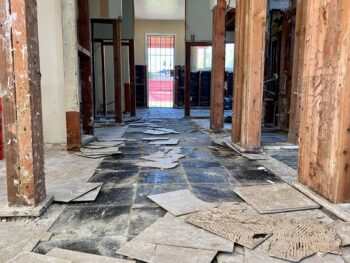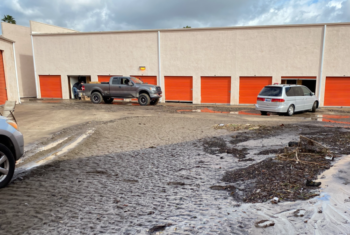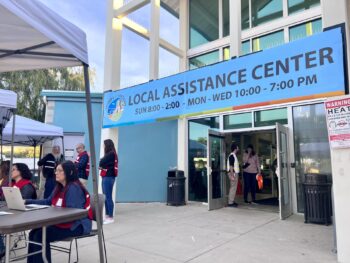Despite some rattled nerves Monday morning, no injuries or major damage were reported after the 4.7 magnitude earthquake in Anza, but what if it had been a stronger earthquake or was centered in San Diego County? Are you ready for it?
The earthquake occurred just before 10 a.m. on the San Jacinto faultine and was felt in San Diego as well as Los Angeles, Riverside and San Bernardino counties in Southern California. The moderate quake should serve as a reminder that we live in a seismically active region. Even when it feels like it’s not moving the earth’s tectonic plates and the energy are always in motion. Most of the time, the earthquakes are too small to feel.
Beyond just knowing this, San Diegans can do a lot to prepare in the event of a major earthquake. Being prepared can make all the difference for the safety and survival of you and your family in a major disaster.
Learn what to do before, during and after an earthquake, by visiting www.ReadySanDiego.org. Download a free template for a family disaster plan and create a home emergency kit.
Being informed is also key in a disaster and the County’s free SD Emergency app is a great resource. While the SD County Emergency App also has preparedness information, its greatest use may be during a disaster when it shows up-to-date road closures, open shelters, health warnings and other information. Download the free app at www.sdcountyemergency.com, the Apple App Store, Google Play and www.readysandiego.org.
If a strong earthquake were to occur, the water and gas lines could be compromised and phones and electricity could be out. Roads could be unsafe to use due to damage or debris. At the same time, if there were damaged buildings, emergency officials would be tied up with priority calls. That’s when you will need to rely on your emergency preparedness stores.
1. Prepare. Gather items for a home, work and car emergency kit. At minimum, you will need a three-day supply of water, non-perishable food, a first aid kit, a whistle, a radio, flashlight and batteries. The items should be stored in a ready-to-grab waterproof bag or container, such as a plastic tub. Pre-packaged emergency kits are available at some big box stores or at the American Red Cross, but residents can also put their own kits together by buying items or gathering items from home.
Personalize your kits for your family by considering the dietary needs of infants, pets and other family members. If anyone in your family requires medication, keep an extra week’s supply in your kits. Keep a copy of important documents such as insurance policies, identification, and bank records in case you have to evacuate quickly. You can scan and store them online or on a thumb drive. Do the same with family photographs.
2. Plan. A disaster could happen while parents are at work and children at school. We cannot count on phone lines because they can quickly get overloaded. So it’s important to have a Family Disaster Plan that includes several meeting places and an out-of-state emergency contact who family members can call or text message. Text messaging is often a more successful way to communicate during a disaster.
Create a complete Family Disaster Plan with important phone numbers and information you may need in an emergency. The plan templates are available in English, Spanish, Tagalog, and Vietnamese on www.ReadySanDiego.org. If you have a plan, review it, make sure it is still up-to-date, and practice it.
3. Stay informed. During an emergency, you will want official information. The County of San Diego emergency website is www.sdcountyemergency.com and will be updated with news including road closures and shelters. If you prefer a mobile version, download the County’s free mobile app.
Residents can also sign up to get free emergency alerts by cell phone during a disaster. To register, go to www.ReadySanDiego.org and click on AlertSanDiego.
If the power is out, you can use your battery-powered radio to get updates from KOGO 600 AM or XTRA Sports 1360 AM. Residents can call 2-1-1 for emergency updates or services.
The County of San Diego also will also send out information on the County’s Twitter accounts at http://twitter.com/#!/readysandiego and http://twitter.com/#!/SanDiegoCounty.
The family disaster plan includes these tips and more for earthquakes:
Before:
- Check home for potential hazards – things that can topple over and cause injury.
- Secure televisions, bookshelves and other heavy furniture to the wall.
- Use special hooks to secure photos and art to walls.
- Plan and rehearse where you and your family can seek cover in each room of your home.
During:
- Drop, Cover and Hold On. Get down low to avoid falling, find a sturdy desk or table to seek cover under and hold onto it while covering your head with your other arm.
- If there are no tables, find an interior wall that is not near any heavy furniture or near glass picture frames, windows or under light fixtures, scoot down and cover your head.
- If outside, find an open area away from buildings, trees, or overhead utility wires, sit down and cover your head.
After:
- Check your home for potential hazards.
- If you smell gas, turn it off at the valve.






